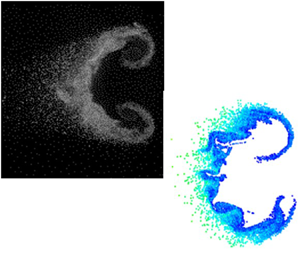Article contents
Evaporation and breakup effects in the shock-driven multiphase instability
Published online by Cambridge University Press: 03 December 2020
Abstract

Evaporation and breakup of liquid droplets are common in many applications of the shock-driven multiphase instability (SDMI), such as in liquid-fuelled detonation engines, multiphase ejector pumps and turbines and explosive dispersal of liquid particles (i.e. chemical or biological agents). In this paper, the effects of evaporation and breakup of droplets on the mixing induced by the SDMI are considered through simulations and compared with experimental results. The evaporation model is validated against previous experimental data. The capabilities of the simulations and particle models are then demonstrated through a qualitative comparison with experimental results where breakup effects are negligible (i.e. small droplets). The simulation results are explored further to quantify the effects of evaporation (i.e. mixing enhancement) in the SDMI, providing further insight into the experimental results. A new breakup model, derived from previous works, is then presented for low Reynolds number (below 500), low Weber number (below 100) droplets in a shock-driven multiphase instability. The breakup model capabilities are then demonstrated through a comparison with experimental results where breakup effects are significant (larger droplet sizes). Finally, the simulation results are used to highlight the importance of breakup parameters on the evaporation rate and large-scale mixing in the SDMI. Overall, it is shown that evaporation is enhanced by the large-scale hydrodynamics instability, the SDMI, and that breakup of the droplets significantly increases the strength of the instability, and rate of droplet evaporation.
- Type
- JFM Papers
- Information
- Copyright
- © The Author(s), 2020. Published by Cambridge University Press
References
REFERENCES
- 14
- Cited by





